10+ Things to Make With Calendula Flowers
Here are over 10 creative ways to use calendula flowers for skin care and health!
I’ve also included a free printable reference sheet about growing and using calendula flowers. Just scroll down and click on the thumbnail to open. (No email signup required.)
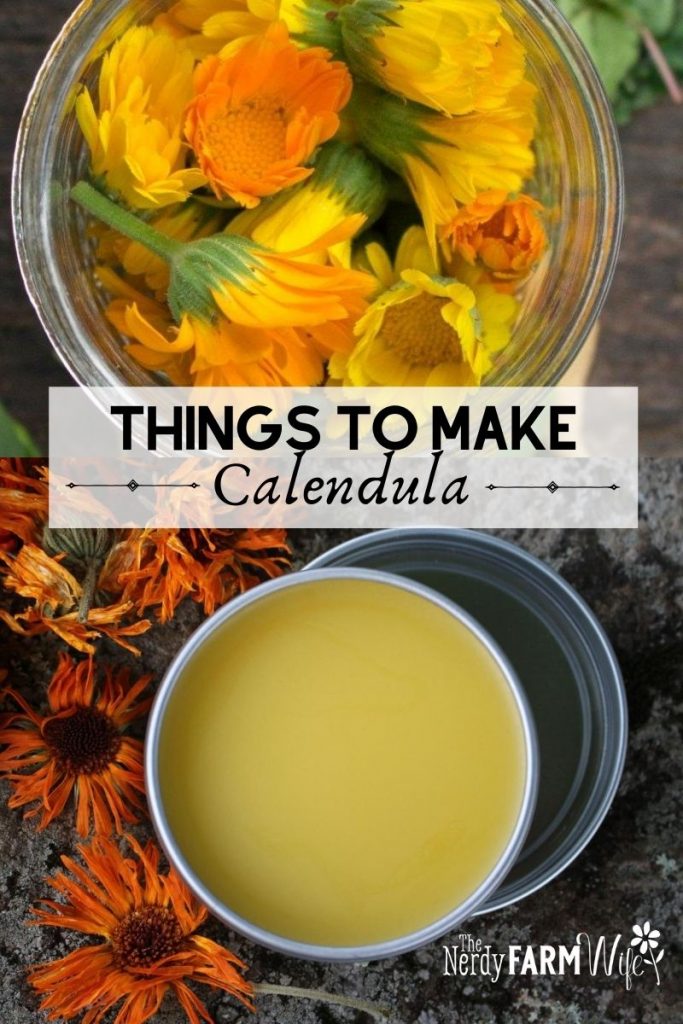
Calendula (Calendula officinalis) is an easy to grow herb whose flowers are traditionally used for their beneficial properties:
- skin soothing
- antiseptic
- healing
- anti-inflammatory
Calendula is sometimes called pot marigold, which makes it easily confused with common garden marigolds, so make sure you’re working with the right plant.
Visit our sister site, Unruly Gardening, for a helpful article and visual chart showing the differences between calendula (Calendula officinalis) and marigolds (Tagetes spp).
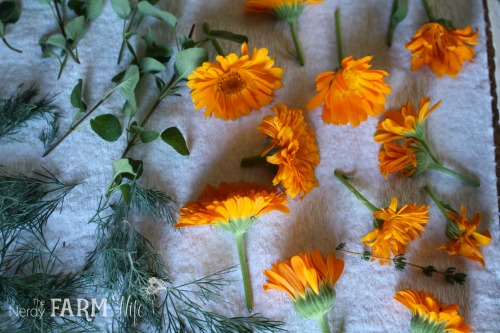
A few notes before we begin:
1. If your calendula flowers are fresh, you’ll need to dry them before making most of these recipes. To do so, spread the flower heads out in a single layer on paper towels or clean dish towels and let them air dry for several days.
2. If you don’t grow your own calendula, you can purchase dried organic flowers from Mountain Rose Herbs.
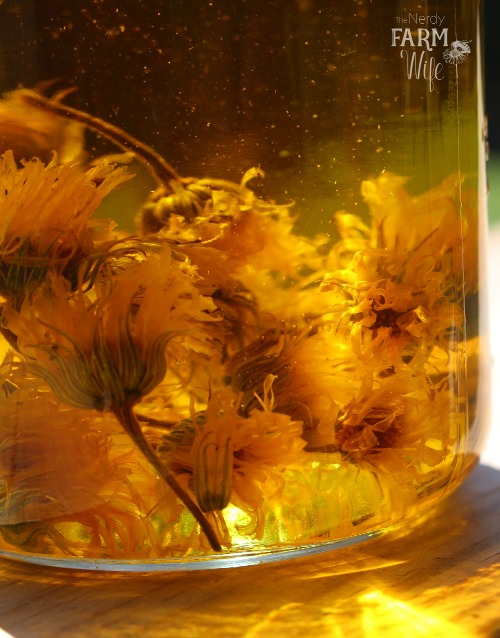
1. Calendula Flower Infused Oil
Calendula infused oil can be massaged directly onto dry, irritated skin or used as an ingredient in recipes for salves, diaper balm, lotions, creams, soaps, and lotion bars. Shelf life of strained, infused oil is around 1 year.
You’ll need:
- dried calendula flowers
- your favorite oil (sunflower, sweet almond, rice bran, apricot kernel, etc)
To make it, fill a canning jar about half-way up with dried calendula flowers. Cover with about twice as much as your favorite carrier oil, or to the top of the jar.
For a quick infusion: Set the uncovered jar down into a small saucepan filled with a few inches of water. Heat over a low burner for a few hours, keeping a close eye that the water doesn’t evaporate out. Remove from heat and strain. The quick infusion is the best way to infuse coconut oil.
For a slower, more traditional infusion: Cap the jar of calendula flowers and oil and tuck away in a cabinet for around 4 to 6 weeks, shaking occasionally as you remember to. When the infusing time has passed, strain.
For an alternative option: You could also set the jar of flowers and oil in a sunny windowsill for several days to a week to jump start the infusion. (Don’t store for long periods in sunlight though, as it tends to fade flowers and herbs over time.)
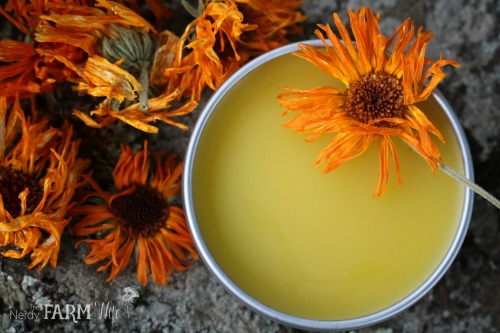
2. Calendula Flower Salve
This recipe uses the infused oil we made above. It’s perfect for including in your first aid kit since it helps soothe many minor skin ailments such as scratches, dry spots, diaper rash, razor burn, minor scrapes, insect bites and more. Calendula salve can be used on pets and farm animals too!
To make it, combine 3.5 oz (100 g) of calendula infused oil with 0.5 (15 g) beeswax in a heatproof jar or empty tin can. (For a vegan option – try using roughly half as much candelilla wax instead of beeswax.)
Set the jar/can down into a saucepan containing an inch or two of water. Place the pan over a medium-low burner and heat until the wax is fully melted. Pour the melted mixture into tins or jars. Shelf life of calendula salve is around 1 year.
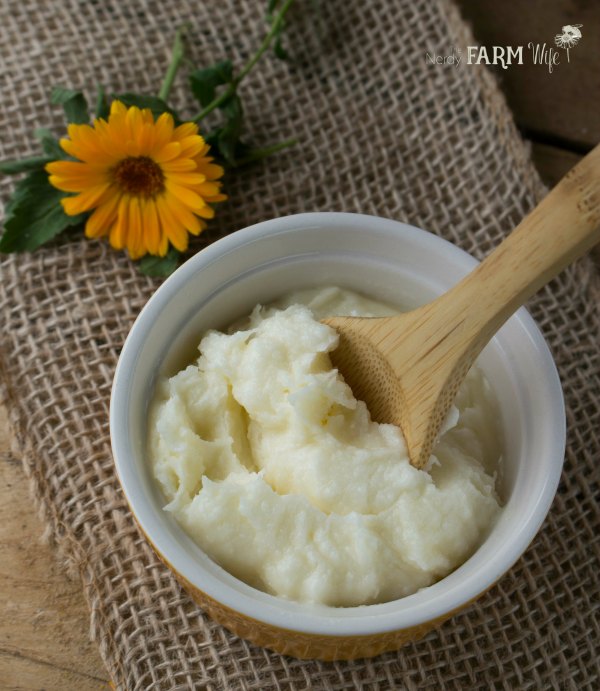
3. Whipped Calendula Coconut Oil
This is a super simple recipe that requires only two ingredients:
- dried calendula flowers
- coconut oil
To make:
- Infuse calendula flowers in coconut oil, using the quick method (see #1 above.)
- Once fully infused and strained, pour the melted calendula-infused coconut oil in a bowl and place it in the refrigerator for about 20 to 30 minutes or until it starts firming up.
- Remove from the refrigerator and beat the chilled oil with a handheld mixer until it’s light & fluffy. This may take up to 5 minutes.
- Scoop the coconut oil in a jar and store in a cool area that stays under 76°F (24°C), the melting point of coconut oil.
This recipe can also be found in my Big Book of Homemade Products.
4. Calendula Lotion Bars
Lotion bars are the best thing ever for dry, cracked skin. They’re really easy to throw together and make wonderful gifts too!
Lotion bars are usually made with equal parts (by volume) of infused oil, beeswax and a vegetable butter, such as shea, mango or cocoa. If you make a lotion bar and it feels too soft, just remelt it and add more beeswax. If it feels too hard, remelt it and add more oil. Lotion bars are very forgiving to work with!
To make, combine 1/4 cup (52 g) calendula infused oil, 1/4 cup (28 g) beeswax and 1/4 cup (44 g) shea, mango or cocoa butter in a heatproof canning jar or upcycled tin can. (For a vegan version, use roughly half as much candelilla wax instead of beeswax.)
Set the jar/can down into a saucepan containing an inch or two of water. Place the pan over a medium-low burner and heat until everything is melted. If you’d like to add a few drops of essential oil for scent, do so at this point. Pour the melted mixture into heatproof silicone candy molds.
To use, rub a lotion bar over your skin wherever it feels dry. They’re especially helpful for spot treating rough feet, knees and elbows. Store your lotion bars in a cool area, out of direct sunlight and they should have a shelf life of around 9 months to a year.
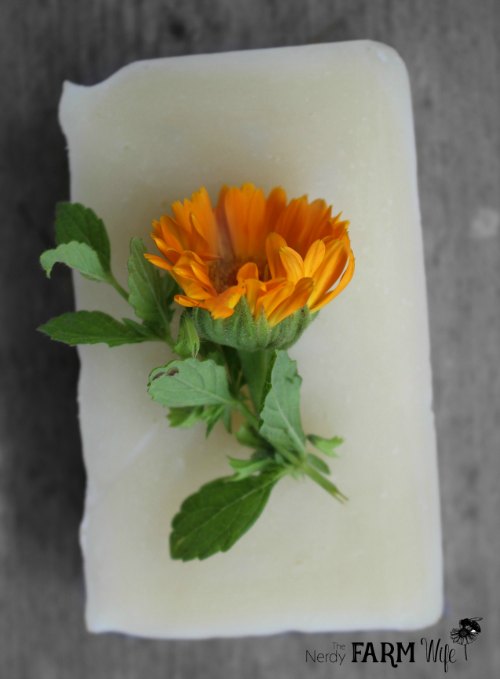
5. Calendula Bar Soap
This is a mild, unscented calendula soap bar that’s very gentle. It’s made with calendula infused oil and calendula tea.
You can find the recipe for calendula soap HERE. (If you’ve never made soap before, visit my Soapmaking 101 post, HERE, first.)
Or, you may also like this Calendula Tallow Soap recipe over at Homestead Honey.
6. Calendula Liquid Soap
This soap is made using a crock pot and potassium hydroxide, to form a soap paste that you can dilute and use as liquid soap.
You can find the recipe and tons of information on making liquid soap from scratch in my article:
How to Make Herbal Liquid Soap from Scratch {+ recipes}
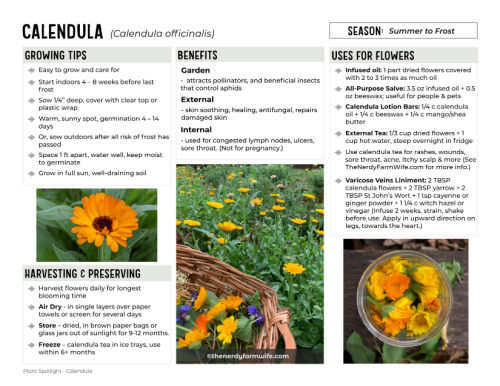
Printable Calendula Reference Sheet
Here’s a “cheat sheet” on growing and using calendula flowers. Just click on the thumbnail of the chart above and it will open up a PDF file that you can save or print.
If you have trouble opening it up, just let us know by writing to hello @ the nerdy farm wife . com and we’ll be glad to help troubleshoot!
This link may change as the chart gets updated over the years, so be sure to bookmark or share this page and not the chart itself. Feel free to share with friends, family, and co-workers! (Just don’t charge for it – it should remain free of cost for anyone, at all times.)
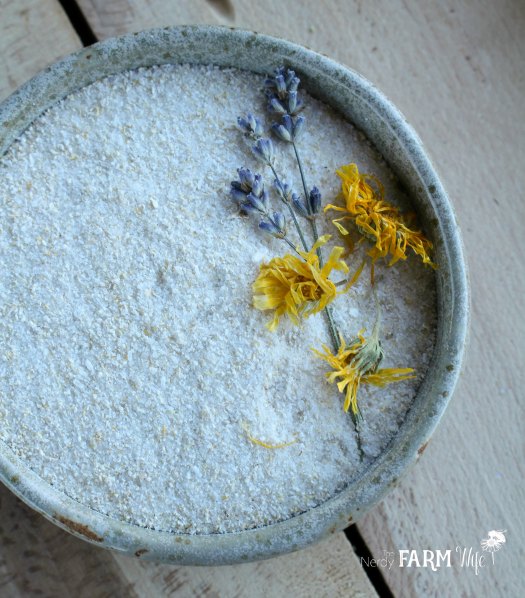
7. Calendula Oatmeal Soak
This bath soak is specially designed for sensitive or itchy skin types. Ground oats soothe irritated skin while calendula flowers calm inflammation. If desired, you can also add a few drops of lavender essential oil for a light relaxing scent.
Ingredients needed:
- 2 tbsp dried calendula petals
- 1/4 cup (26 g) rolled oats
- 1/2 cup (144 g) fine sea salt
- 1/4 cup (63 g) Epsom salt
- 2 to 3 drops lavender essential oil mixed with 1/4 teaspoon olive or sunflower oil (optional, for scent)
How to Make: Using an electric coffee grinder, blend the oats and calendula together until finely powdered. Stir together the sea salt and Epsom salt. If using, add the diluted lavender essential oil. Add the powdered oats and calendula and stir until all of the ingredients are thoroughly combined. Store the soak in a tightly closed glass jar for three to four months, keeping in mind that the scent may fade over time.
How to Use: To use, dump the entire cup of bath soak into a bathtub as it fills with comfortably warm water.
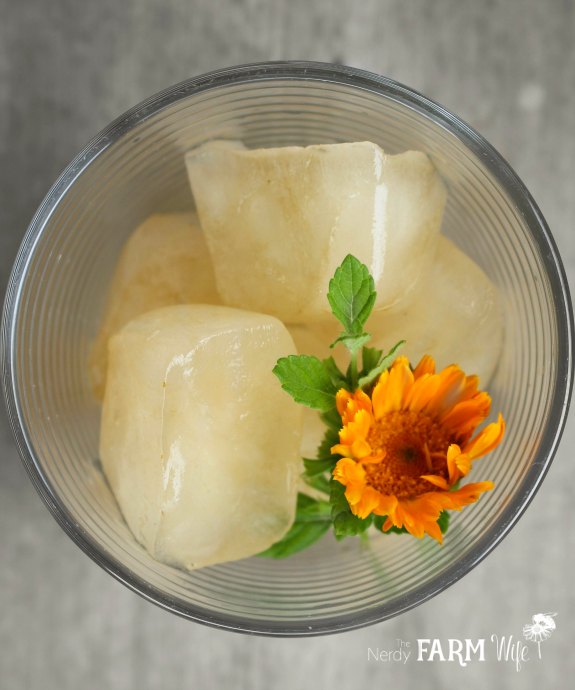
8. Calendula Tea
Calendula tea can be used for all sorts of things, from a sore throat gargle to a disinfecting wound spray to a hot spot treatment for dogs.
You can read more about 14 ways to use calendula tea, HERE.
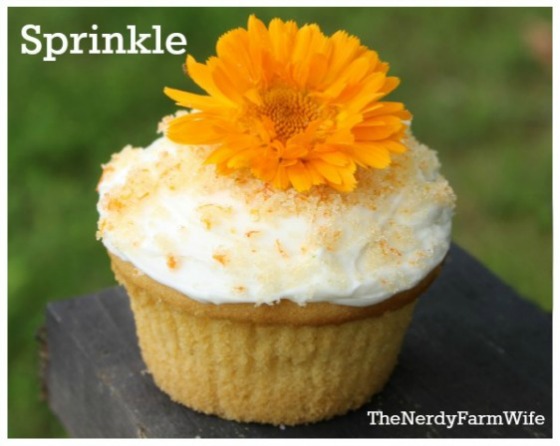
9. Calendula Cupcake Sprinkles
Edible flowers, such as calendula, can be used as all-natural colorants to create cupcake and baking sprinkles that are free from fake colors.
You can find the directions to make them in my article, Naturally Colored Decorating Sugar (using edible flowers). (If you’re sugar free, try the coconut version instead!)

10. Calendula Cream
This lovely calendula cream is thick and rich, almost like a body butter, and can be used like lotion or like a healing salve.
You can find the full recipe and directions to make, over HERE at the Grow Forage Cook Ferment blog.
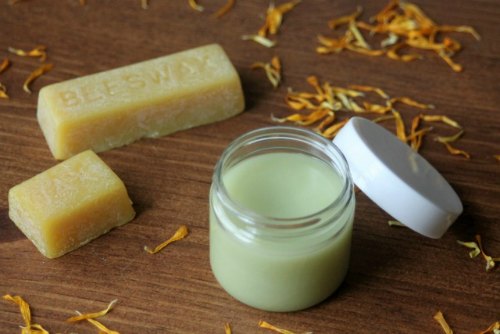
11. Calendula Cocoa Butter Balm
This Calendula Cocoa Butter Balm is filled with nourishing ingredients. The cocoa butter is deeply moisturizing and the infused oils are softening and healing as well. The beeswax adds some hardening and further protects the skin.
You can find the full recipe and how to make it, over HERE at the Homespun Seasonal Living blog.

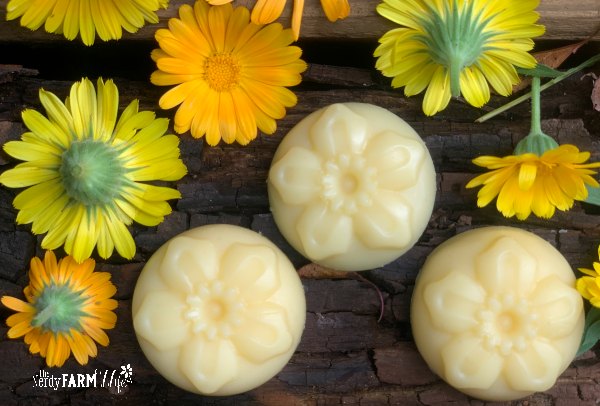


thanks Jan for all these beautiful recipes.I am anxious to get started on them all. I esp. love the calendula recipes since I had purchased a big bag a while back and wasn’t sure where to go with it. The cream and salve sound terrific and they will be my first projects. Thank you for your generosity and for letting us enjoy a sample of these wonderful flowers in your recipes.
Hi Mariann, So glad that you enjoy the recipes! I bought a big bag of calendula a while back too – it was much more than expected, but fun to play with! :)
I am now a fan of yours and it all started when my daughter sent me a video on dogs paw cream for winter. Here our pups get dry skin from walking in
the winter. Well once I made the oil and eight containers of “dog paw wax” I began to look for other uses for this oil. I down loaded your e book and am off to the races. Thanks for your generous contribution to my knowledge base and not only are all the dogs I know getting some but my
friends with dry skin will be getting the cream.
Merry Christmas to you and yours!
Hi Elaine, I’m so glad that you’re enjoying the ebook and recipes! I hope you have a very Merry Christmas too! :)
Do the flowers need to be dried to infuse?
Hi Jen! Yes, I like to start with dried flowers. That eliminates the risk of mold and bacterial contamination from decaying plant matter trapped in oil.
I just infused some calendula and I hate to toss the flowers, what do you do with your used infused flowers?
Hi Lisa! I usually run a second round of oil over the infusion, adding in some more dried flowers if possible, so I get a second use from them. There’s not a lot you can do with them after that, except to scatter them outside. (Not dumped all in one place, because the oil on them isn’t great for any plants or little critters they land on.)
Hi! I made some Calendula salve but it’s a little too oily/greasy. How can I fix that for future reference?
Hi Kelli! That has a lot to do with the type of oil used.
Oils that absorb into your skin quickly will feel less greasy than oils that absorb slowly.
Some less greasy oils to try in your next recipe include: jojoba, rice bran, apricot kernel oil, grapeseed, safflower, rosehip.
Fractionated coconut oil (the kind that’s liquid even when cold) is excellent for making products feel lighter on your skin.
You could use about 1/4 of the oil amount as fractionated coconut oil in most recipes & it will feel less greasy.
Heavy oils that feel greasier include olive, sunflower, regular coconut oil – so using less of those, or combining them with light oils will help! :)
Hi Jan!
If I wanted to add some vitamin e oil to the salve, how much would you suggest?
Hi Talia! I confess to always doing the “eyeball method” where I just squeeze a capsule of vitamin E oil into my still-hot salve mixtures, stir it in really well, and call it good.
If you want to be consistent and precise though, check with the manufacturer of your vitamin E.
There are different strengths and concentrations of vitamin E, so one brand might recommend a 0.5% usage rate, while another might recommend a 3% usage rate.
I was recently gifted one of your books and intrigued by your carrot and calendula soap recipe I ordered a soap mould and lye.
I made it today, oh Jan, it’s delicious! I’m amazed it smells so good with only the flowers, carrot juice and honey to bring it to life like that.
I didn’t have sunflower oil so substituted with sweet almond and camellia. My home-grown calendula is infused in grapeseed oil so I used that instead of making a batch in olive. And to butcher your amazing recipe even further, I used fractionated coconut.
I did the hot method, simply because you said that although waiting a few weeks for it to harden is better, I could still use it right away.
I love the earthy colour and scent, the lush lather and the soothing nourishingness, haha, is that even a word? I’m thrilled my first ever foray into this scary soap making world turned out so brilliantly!
Thank you so very much for your generosity and inspiration.
Hi Jacqueline, Hooray! I’m so happy that your first soap turned out so well! I love how you got so creative with your first batch too – that’s always wonderful to hear! <3
okay so a friend told me to just put the flowers, not dried, just fresh, in coconut oil. it has been sitting there for weeks. I am noticing a beautiful pink come around the flowers… is that mold? do I need to toss it all?? can I hear it and remove? or is it something else??
Hi Danielle! Fresh flowers will tend to spoil if they stay in oil a long time.
It’s often best to use dried for oil infusions, but if you do use fresh – keep the jar uncovered, and use a low heat method for a few days, rather than weeks.
I suspect that’s some type of microbial buildup you’re seeing and would discard the whole batch of oil/flowers & start over with some dried calendula. :)